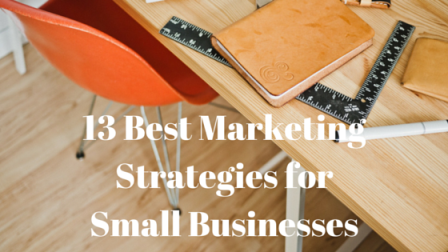Whether you have just started a small consulting business, run a local consignment shop, or opened a café, you are constantly looking for ways to attract business without breaking the bank. Here are my best strategies, digital and off-line, to market your business while ultimately saving you money!

#1: Set a Goal and a Budget
The first step to marketing is defining your end-game and strategizing your budget. The first question consultants ask those big, bad corporations going through restructuring is, “What do you want?” This is when you need to decide what is important to you; do you want to extend your reach or maximize local exposure? Are you looking for brand awareness or conversions?
Tips to try now:
- Try Mint. It has a great interface for managing small budgets and keeping track of your money efficiently.
- Start prioritizing your goals. What are your most immediate need and your most important long-term objective?
#2: Pay to Play
As I learned with my first lemonade stand, you have to spend money to earn money. Marketing is the same way—if you want to make a positive impact, you are going to have to spend some of your budget on paid search ads, display ads, social ads, etc. It can be intimidating. Especially when your head is spinning with questions; how to get started, how much it costs, how to know if Facebook Ads or AdWords even work. Whether you tackle this yourself or hire someone else to help, it can be so worth it!
Why do I need to pay for Facebook Ads, you ask? Due to some Facebook trickery, unpaid views on Facebook posts may be as low as 1% of your audience.

Tips to try now:
- If you’re using AdWords, see if it’s working.
- Use a cost calculator to see what you could get out of a small Facebook ads budget.
- If you’re doing neither, check out PPC U for help getting started.
#3: Capitalize on Google’s Local Offerings
As the most widely used search engine, Google has a surplus of offerings that can help your business. As part of an initiative that started in 2015, Google ran Let’s Put Our Cities on the Map in order to get local businesses online. According to BCG Report, The Connected World, businesses that have an online presence grow 40% faster than those that don’t. If you missed the boat, now is time to hop on the bandwagon!
By creating a Google My Business account, you can take control of the information about your business, such as hours of operation, address, phone number and website. Now, with the new local search ads, your business can appear on the Google Maps app or website.
Tips to try now:
- Get a Google My Business account.
- Google your business—check out the information already there, see what you can do to improve it.
#4: Champion One Social Channel
I’ll be the first to admit, social media is hard and irritating. Especially when you are trying to juggle Facebook and LinkedIn and Instagram and Pinterest and Google+ and Twitter. It’s hard to tell if it even works at all! Having a presence across channels is great, but I’ve found it is more effective to choose one channel that your customers are most present on to pursue.

For example, if your customers are constantly tagging your location or handle in Instagram posts but rarely retweeting you on Twitter, invest more time in Instagram (which is conveniently easy to share on Facebook as well). If you are a creative designer, you may want to look into Pinterest—a half-life on Pinterest is substantially longer than any other channel #recycling.
Tips to try now:
- Analyze your current social media presence. Where are you seeing the highest engagement?
- Sign up for some social tools! Hootsuite and Buffer will link up to your social accounts, allowing you to schedule posts for the future. Mention helps you monitor keywords, and Feedly is a handy-dandy RSS reader so you can stay informed. Speaking from experience, these can alleviate a LOT of stress.
#5: Email Marketing
When you’re a small business, email marketing is a perfect opportunity to establish loyalty. If your customers and prospects are handing over email addresses, it opens the door to send out sale or event notifications. If sales and events aren’t really your speed, think about sending a weekly or bi-weekly newsletter. People are more likely to be loyal and engage with a business that shows its humanity; take the time to announce new employees, an award or even big family events; i.e. “If you are wondering why our fabulous designer Joanne has been MIA, it is because she just became a mom! Look at this beautiful cherub (insert baby picture here). She will be back in action next week, come by to congratulate her!”.
Tips to try now:
- If you’re looking to save money here, sign up for MailChimp. They have a free email marketing service with great features, including predesigned templates.
- Email optimization: Keep testing subject lines, time of day, time of week, creative; use best practices to eliminate variables in these tests.
- Lots of people check their email on their phones, so make sure your emails are mobile-friendly, using CSS or smaller pixel width (smaller than 600px).

#6: Publish a Blog
Blogging is not only fun (think of all the time you can now justify spending on memes), it can be hugely useful for exposure and branding. Your company blog is where you should demonstrate to potential customers and fans that you’re an expert in your field and are dependent upon for guidance and advice.
You can also utilize this platform to brag! Anything from award announcements, project completions, hitting big milestones or preaching about your business savvy is fair game here.
Tips to try now:
- Quality over quantity but consistency is important. Commit to publishing a new blog post at least once per week.
- Check out Drizly for tips and examples of great blog posts tailored to their industry.
- Make sure you’re optimizing for SEO so people can find your blog content.
#7: Do Keyword Research for SEO
If you have no idea what SEO is, you’re in good company. Search engine optimization is a series of tactics used by marketers to obtain higher placements on the search results pages of Google, Bing, Yahoo or other search engines in order to increase visits to their website. The good news? It’s free! The bad news? It’s tricky.
It can take a long time to start seeing results from SEO, but it pays off in the long run. One of the easiest things you can do now to increase your search engine traffic over time is keyword research. Keyword research tools will tell you what words and phrases your target audience most often uses when searching for information or products that your business can provide. As a smaller or newer business, you’ll find it hard to compete with bigger, more established brands for rankings on very competitive keywords, so it’s best to start with long-tail keywords, which are more specific and less competitive.
Tips to try now:
- Start by identifying a list of keywords that will bring relevant visitors to your site. Utilize keyword tools to help: WordStream’s Free Keyword Tool, Google’s Keyword Planner, or KWFinder
- Think of the problems you’re trying to solve for you customers. Search Quora, Reddit, or Yahoo Answers to see what words are being used to talk about it.
- Incorporate those keywords in your content, to make it more discoverable. Keywords should appear in your title tags, body content, headings, image file names, and meta description so search engines can “see” that your content is relevant to the right searches.

Get all eyes on you with SEO
#8: Share Your Knowledge
How do you do what you do better than anyone else? Knowledge shares can be anything from YouTube tutorials to webinars, to speaking at local conferences. You could repurpose your presentations and put them on your blog!
Tips to try now:
- Choose a hot topic in your industry to address.
- Check out these tips on how to do a webinar, including tips for topic selection, promotion, and technical considerations.
- Follow up with both attendees and non-attendees.

#9: Network, Leverage Local
Be active on LinkedIn! This is a great way to find others in your industry, join chat groups and forums for advice or event invites. Book a booth at a town fair. Sponsor a few recreational sports teams in the area to place your logo on the back of a shirt. Have a local magazine or newspaper run an advertisement, maybe even with a discount “if you mention this ad”. Host your own event! Invite your community to an open house or lunch and learn session.

#bonding, you know what I mean?
Another route to take is volunteering! Have your co-workers get together to help a local cause (offering a day off for volunteering sounds good to me). Do good and help your business.
Tips to try now:
- Find a local Habitat for Humanity project.
- Check your calendar—is your business seasonal? When is an opportune time to have an event?
- Contact your favorite trade publication, ask if they accept guest submissions and pitch them a topic.
#10: Survey, Listen, Learn
Look for feedback, because the best companies are constantly improving. After completing a service, ask your customer to comment on their experience. Offer a discount to email subscribers who complete a survey, or have printed surveys and pens on hand at your store—if you’re fancy, have a customer complete a survey on her phone or tablet to get a discount before purchasing. The feedback is great in two part; it can inform on your business’ best practices and result in some handy testimonials, and highlight the areas that need improvement.
Tips to try now:
- Choose an area where you need feedback or testimonials.
- Decide what it’s worth to you—10% off? $ 5?
- Look into these survey tools.
#11: Apply for Awards
My personal favorite part of winning awards is the swag that goes along with it. You are presented with a trophy, or a medal, or even just a badge, that you can then place in a prominent place to assert that your business savvy is, in fact, the best. Award shows are also another great place to network! You would be surprised at the sheer amount of awards available—you may even be able to run unopposed—check with your local news publications to see what is in your area.
Tips to try now:
- Curate a list of the type of awards you could apply for, i.e. Best Design Team, Best Blog Post, etc.
- Check these awards out!

#12: Revisit Your Landing Pages
If you’re doing any kind of advertising or email marketing, your landing pages are where the rubber meets the road – where people who are interested in your offerings decide to “convert” into a lead or a customer or not. Landing page design can have a huge impact on your conversion rates—WordStream conducted a study in 2014 that showed the best advertisers achieve conversion rates of 10% or more on their landing pages.
Tips to try now:
- Analyze your current landing page conversion rate. If it’s dismal (2% or less) the design may not be the problem; you may just need a more enticing offer.
- Once you know your offer is awesome, start running A/B tests on your landing pages. Here are five tips for running an A/B test on a budget.
- Some no-brainer things to test: Headline, the length of landing page copy, the length of a form, size and placement of a button, and your call to action.
- Check out these tips, examples, guides, and tools. It’s a lot of reading, but it’s worth it.
#13: Be Different
Stand out from the crowd. Be a unicorn in a herd of donkeys. Be original and quirky and uniquely represent your business through advertising and marketing. Show everyone not only why your business is awesome, but why it is head-and-shoulders above everyone else.
Tips to try now:
- Take a controversial stand on an issue or trend that affects your industry
- Don’t just parrot “best practices”; produce original data that other businesses will want to cite
- Take the time to create a striking “About Us” page that showcases your unique mission statement and staff
(113)







